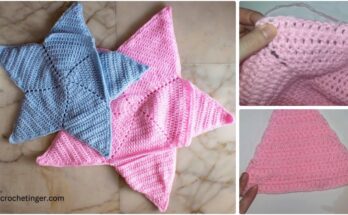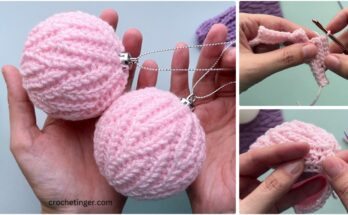
1. Introduction
Crochet has long been a cherished craft that brings together creativity, comfort, and practical use. Among the many beautiful items you can make, one of the most elegant and functional projects is the crochet sousplat doily. While its name might sound fancy, making one is surprisingly easy and can bring charm and warmth to your dining table, coffee station, or decorative shelves. In this detailed guide, you will not only learn how to make a crochet sousplat doily step-by-step, but you’ll also discover how to choose the best materials, avoid beginner mistakes, explore creative designs, and even turn your hobby into a potential income source.
If you’re someone who enjoys combining aesthetic beauty with utility, or you’re looking for a new project that’s both beginner-friendly and endlessly customizable, then making a crochet sousplat doily might just be the perfect fit. By the end of this blog, you’ll have the knowledge and inspiration to craft your own handmade masterpiece—and the skills to replicate and innovate on the design whenever you please.
Are you ready to dive into a beautiful and rewarding crochet journey? Let’s get started by first understanding what a sousplat doily really is and why it’s a wonderful project to add to your crochet portfolio.
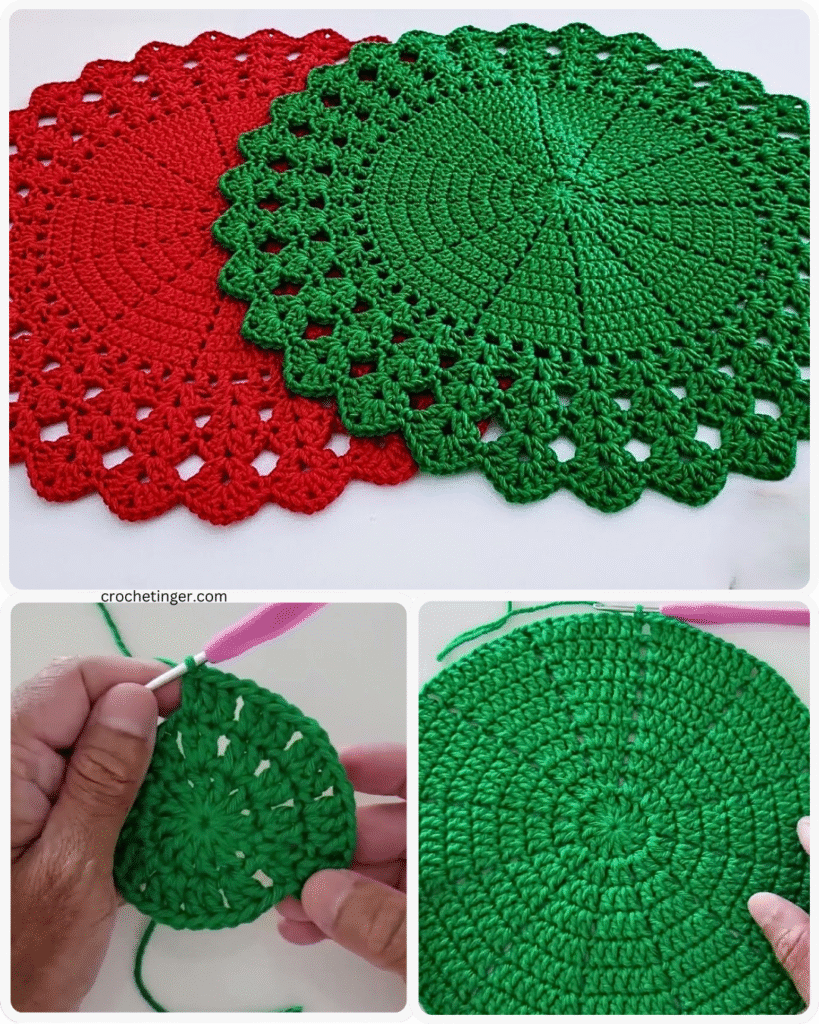
2. Understanding the Purpose of a Sousplat Doily
Before we jump into hooks, yarn, and patterns, it’s essential to understand the purpose and significance of a sousplat doily. The word “sousplat” is derived from French and translates to “under the plate.” In practical terms, a sousplat is essentially a decorative placemat or charger plate that is placed beneath dinnerware to elevate the aesthetic of a table setting. It’s meant to enhance presentation, define space for each guest, and protect the table surface from heat, moisture, or spills.
In crochet, the sousplat becomes more than just a functional accessory—it becomes a canvas for design and expression. Unlike traditional placemats, crochet sousplats often feature intricate lacework, floral motifs, circular mandala-style designs, and beautiful color combinations that can turn any table into a work of art.
Here are a few reasons why crochet sousplat doilies are loved:
- Visual Appeal: With just a few stitches, you can create a stunning decorative base that instantly makes your dining table look refined and thoughtful.
- Customization: You can make crochet sousplats to match any theme—whether it’s minimalist, rustic, floral, modern, or holiday-inspired.
- Reusable and Washable: They’re environmentally friendly and can be reused for years with proper care.
- Conversation Starter: A handmade item on the table often invites admiration and questions from guests, giving you the opportunity to share your passion for crochet.
These doilies are not just for show—they also serve real functions in homes where entertaining is frequent or aesthetics are given importance. Whether you’re preparing for a festive family dinner, a wedding reception, or just a cozy brunch, your handmade crochet sousplat doilies can set the perfect tone.


3. Benefits of Making Your Own Crochet Sousplat
Crocheting your own sousplat doilies isn’t just a fun hobby—it offers a wide range of benefits, both personal and practical. From creative fulfillment to cost savings, this handmade project provides value that goes far beyond its beautiful appearance. Whether you’re an experienced crocheter or a curious beginner, here are the reasons why making your own crochet sousplat is a truly rewarding endeavor.
1. Creative Expression
One of the greatest joys of crocheting is that it allows you to express yourself. A crochet sousplat doily is like a blank canvas—you can choose your favorite stitch pattern, experiment with color palettes, and decide how big or intricate your design should be. Whether you prefer bold, bohemian styles or soft, vintage vibes, each doily becomes a unique piece of functional art.
2. Customization for Every Occasion
Homemade crochet sousplats give you complete control over the design and size. You can match your doilies to your home décor, coordinate them with specific events (think holidays like Christmas, Easter, or Thanksgiving), or personalize them with colors that match a wedding or party theme. Instead of hunting for the “perfect” placemat at the store, you create it with your own hands.
3. Cost Efficiency
While high-quality placemats or designer table linens can be expensive, making your own crochet sousplats is often much more affordable. With just a few skeins of yarn, a crochet hook, and your time, you can create a full set of beautiful placemats that would cost much more if bought retail. Plus, many of the required tools are reusable, so it becomes more economical with every project.
4. Relaxation and Stress Relief
Crochet has been widely praised for its meditative qualities. Working on a repetitive stitch pattern like a doily is incredibly calming and can help reduce anxiety, ease depression, and promote mindfulness. You’ll find that sitting down to work on your crochet project helps you unwind and disconnect from the hustle of daily life.
5. Thoughtful and Handmade Gifts
Handmade gifts carry emotional value that store-bought items simply can’t replicate. A set of crocheted sousplat doilies makes a thoughtful and elegant gift for housewarmings, weddings, birthdays, or holidays. With a little planning and personalization, your gift will not only be useful but also cherished for years.
6. Perfect for Beginners and Pros
Although crochet lace doilies can appear complex, many sousplat designs use only basic stitches like chain, double crochet, and slip stitch—making them perfect for beginners. Advanced crafters, on the other hand, can push the boundaries with intricate stitch combinations and color changes, making this project equally exciting at every skill level.
7. Income Opportunity
Many crocheters turn their hobbies into side businesses or full-time careers. Sousplats are highly marketable because of their practical use, decorative appeal, and gift potential. You can sell finished products at craft fairs, on Etsy, or through local home décor boutiques. Offering custom color or monogrammed designs can add an extra level of personalization and value.
8. Sustainability and Eco-Friendliness
When you crochet your own items, you can choose environmentally responsible yarns, like organic cotton or recycled fibers. Homemade crochet sousplats help reduce reliance on synthetic, factory-produced tableware and allow you to contribute to a more eco-conscious lifestyle.
With all these benefits in mind, let’s gather everything you’ll need to start making your own crochet sousplat doily.

4. Materials and Tools Needed
Before you begin crocheting your sousplat doily, it’s crucial to gather the appropriate materials and tools. While the project may look intricate, the actual list of items required is quite simple. Having everything ready in advance will help ensure your crochet time is smooth, enjoyable, and productive.
Here’s a complete breakdown of what you’ll need to make your own crochet sousplat doily:
1. Yarn
Your choice of yarn plays a major role in the final look and feel of your doily. For sousplats, you want a yarn that offers both structure and beauty. Here are some options:
- Cotton Yarn: This is the most recommended option for sousplat doilies because it’s durable, absorbent, easy to wash, and holds its shape well. Look for 100% mercerized cotton for a slightly shiny, polished finish.
- Blended Yarn: Cotton blends with acrylic or bamboo can also work well and may offer a softer or more textured feel.
- Size: A medium-weight yarn (category 3 or 4) is ideal for beginners, while thinner yarns (size 2 or lace weight) can give more delicate results if you have experience with fine work.
2. Crochet Hook
Your hook size should correspond with your yarn. Most yarn labels recommend a hook size, but here are general guidelines:
- For medium-weight yarn: use a 4.0 mm to 5.0 mm hook.
- For finer yarn: use a 2.5 mm to 3.5 mm hook.
Adjust your hook if you want a denser or more lacy look.
3. Scissors
A sharp pair of scissors will help you cut yarn cleanly without fraying. Choose a small pair you can keep near your project bag.
4. Yarn Needle or Tapestry Needle
You’ll need a blunt-tipped needle with a large eye to weave in the loose ends of your yarn once your doily is finished.
5. Stitch Markers (Optional)
If your pattern involves rounds, increases, or joining rows in specific places, stitch markers can help you keep track of your work and prevent mistakes.
6. Blocking Supplies
To give your finished doily a polished and professional appearance, blocking is essential. You’ll need:
- Blocking mats or a foam board
- Rust-proof pins
- A spray bottle with water or a steamer
7. Measuring Tape
A tape measure can help you monitor your progress and ensure consistency in size, especially if you’re making a matching set.
Optional Additions
- Beads or embellishments: If you want a decorative edge or central accent.
- Starch spray: For added firmness in more decorative doilies.
Now that you’ve gathered all your supplies, it’s time to dive into the heart of the project: creating your very own crochet sousplat doily, one round at a time.

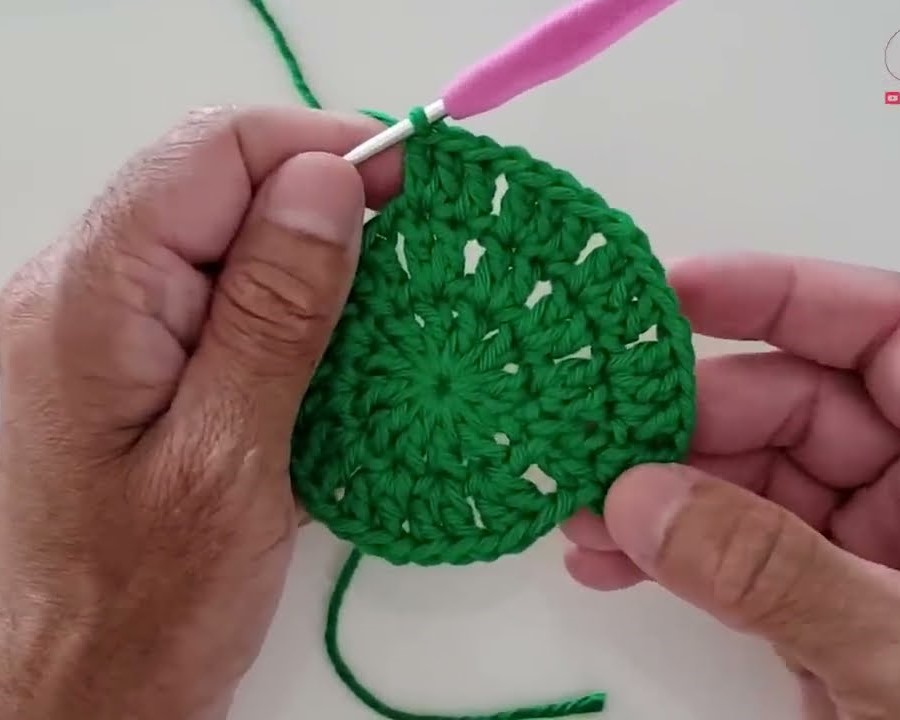
5. Choosing the Right Yarn and Hook for Your Crochet Sousplat
Selecting the right yarn and hook combination can dramatically influence the texture, drape, and visual appeal of your crochet sousplat doily. This is more than a technical decision—it’s also where your creative vision begins to take shape. Let’s look closely at how to make the best choices for your project.
Understanding Yarn Types for Sousplats
Sousplats, also known as decorative placemats, serve a functional and aesthetic purpose. Because they sit beneath plates, they should be sturdy enough to lay flat on a table, washable, and resistant to excessive stretching. That’s why yarn choice matters.
- Mercerized Cotton Yarn
This is the gold standard for crochet doilies. It’s tightly twisted, has a beautiful sheen, and holds up well to wear and tear. Mercerized cotton is less prone to pilling and offers a clean, elegant look that’s ideal for formal table settings. - Recycled Cotton Yarn
A sustainable and eco-friendly choice, recycled cotton yarns are perfect for rustic or bohemian-style sousplats. These tend to be slightly thicker and softer but may require more blocking to maintain shape. - Cotton-Acrylic Blend
These blends provide flexibility and slight elasticity. While they’re a bit softer and less stiff, they offer easier stitch movement and can still look great after blocking. - Color Choices and Design Planning
Whether you prefer neutral tones or bold contrasts, think of how the finished doily will look on your table. Lighter colors work well for daytime and spring events, while jewel tones or deep hues add sophistication and warmth. You can also use two or three shades to create a layered or striped effect.
Choosing the Perfect Hook Size
The hook you use should balance comfort and stitch definition. If your stitches are too tight, your doily will curl or become stiff. Too loose, and it may lack structure.
- Standard Rule: Use the recommended size on your yarn label for best results.
- For Tight Stitchers: Go up half a hook size to loosen the tension.
- For Loose Stitchers: Try going down a size to gain more control and structure.
Here’s a quick reference chart for pairing yarn weights and hook sizes for sousplats:
| Yarn Weight | Recommended Hook Size |
|---|---|
| Sport (2) | 2.5 mm – 3.5 mm |
| DK / Light Worsted (3) | 3.5 mm – 4.5 mm |
| Worsted (4) | 4.5 mm – 5.5 mm |
Experiment Before Committing
Make a small swatch using your chosen yarn and hook to test the fabric. This 10×10 cm (4×4 inch) swatch will show you:
- Stitch clarity
- Fabric drape
- How the color pattern works
- Whether the size is suitable

6. Step-by-Step Instructions to Crochet Your Sousplat Doily
Creating your own crochet sousplat doily is not just a way to add charm to your dining table, but also a gratifying craft journey. The following steps are designed for beginners to intermediate crocheters, using a round-based pattern that grows outward in complexity and beauty.
This step-by-step guide will walk you through making a classic, elegant sousplat doily that’s both functional and decorative.
Pattern Overview
- Skill Level: Easy to Intermediate
- Shape: Circular
- Style: Classic lace-inspired, with waves or floral spirals
- Technique: Worked in the round
Let’s start by understanding the abbreviations used.
Abbreviations (US Terms)
- ch = chain
- sl st = slip stitch
- sc = single crochet
- dc = double crochet
- tr = treble crochet
- sk = skip
- sp = space
- st = stitch
- rep = repeat
- beg = beginning
Foundation: Magic Ring
You’ll start with a magic ring. This is an adjustable loop that allows you to pull your center tight for a polished look.
Round 1: Forming the Center
- Make a magic ring.
- ch 3 (counts as 1 dc), then make 11 dc into the ring.
- Pull the ring tight and join with a sl st into the top of the ch-3.
- (12 dc total)
Round 2: Expanding the Base
- ch 3 (counts as 1 dc), dc in the same st.
- 2 dc in each st around.
- Join with a sl st to the top of the beg ch-3.
- (24 dc total)
Round 3: Create Lace Foundation
- ch 4 (counts as 1 dc + ch 1), dc in next st, ch 1 repeat around.
- Join with sl st in 3rd ch of beg ch-4.
- (24 dc, 24 ch-1 spaces)
Round 4: Shell Formation
- sl st into next ch-1 space, ch 3 (counts as 1 dc), dc, ch 1, 2 dc in same sp (shell made).
- sk next dc, shell (2 dc, ch 1, 2 dc) in next ch-1 sp repeat around.
- Join with sl st in top of beg ch-3.
Round 5: Build on the Shells
- sl st to ch-1 space in shell, ch 3, 6 dc in same sp (7-dc shell).
- sc between shells of previous round, 7 dc in next shell’s ch-1 sp repeat around.
- Join with sl st.
Round 6: Open Lace Round
- ch 1, sc in same st, ch 5, sk 6 dc, sc in sc between shells repeat around.
- End with ch 5, sl st in first sc.
Round 7: Arches of Petals
- sl st into next ch-5 space, ch 3, 6 dc in same space (7 dc total).
- sc in next sc, 7 dc in next ch-5 space repeat around.
- Join.
Round 8: Stabilize and Expand
- ch 1, sc in each st around, working into the top of each dc and into each sc.
- Join.
Round 9: Decorative Picot Edge
- ch 1, sc in next 3 sts, ch 3, sl st into 1st ch (picot made) repeat around.
- Join and fasten off.

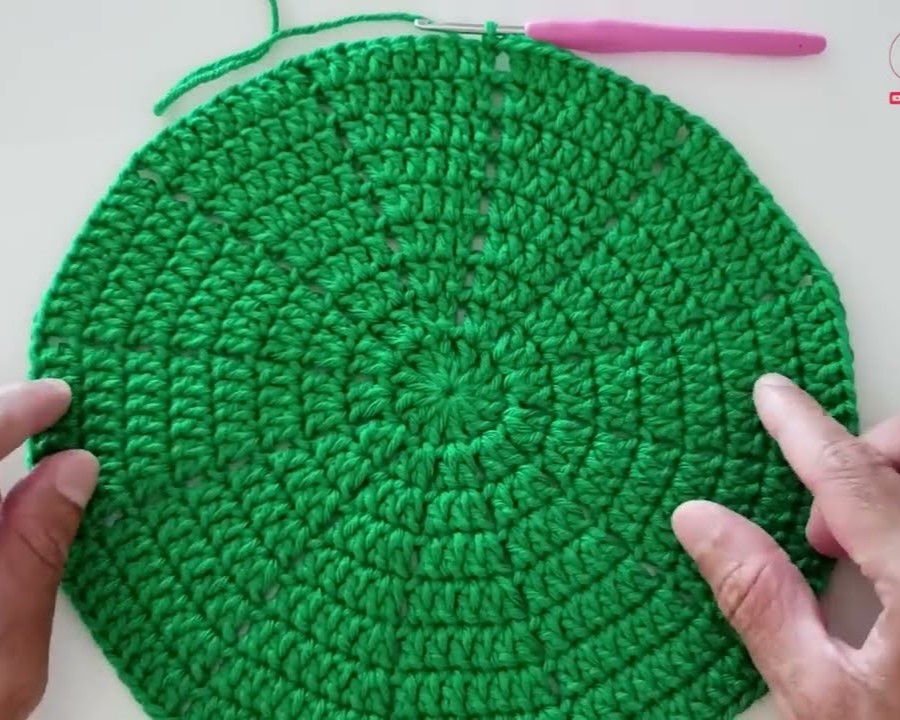
7. Design Variations and Advanced Customizations
Once you’ve mastered the base pattern, it opens up a whole new world of creativity. Customizing your crochet sousplat allows you to match different aesthetics, seasons, or specific table settings. Whether you prefer minimalism, maximalism, or a modern boho style, you can tweak the pattern to suit your taste. Below are several ideas and techniques to make your sousplat one-of-a-kind.
Change Yarn Colors Strategically
Color plays a powerful role in setting the mood of your table décor. You can create harmony, contrast, or vibrancy with just a few yarn switches.
- Two-Tone Ombre Effect
Begin with a darker color in the center and gradually transition to a lighter shade. This creates a visual gradient that draws the eye outward and adds depth to your design. - Seasonal Color Palettes
- Spring: Pastels (mint, blush, lavender)
- Summer: Bold and bright (aqua, coral, sunflower yellow)
- Fall: Earthy tones (burnt orange, olive green, deep red)
- Winter: Jewel tones (emerald, sapphire, burgundy)
- Color Blocking Per Round
Assign a specific color to each round or set of rounds to create a striped, layered look. This makes the structure of the doily even more pronounced.
Use Beads for Extra Elegance
Add beads to specific rounds (especially the picot edge or shell round) to create a more luxurious look.
- Use glass or pearl seed beads.
- Thread beads onto yarn before crocheting, then slide them into place as you complete stitches.
- Secure each bead within a dc or sc stitch for stability.
Try Metallic Threads or Sparkle Yarns
Metallic threads, either as the main yarn or carried along with your cotton yarn, provide a subtle shimmer perfect for holiday tables or special occasions.
- Gold, silver, and copper threads work beautifully for festive sousplats.
- Be sure to test a swatch first, as metallic yarns can be slightly more difficult to work with.
Alter the Size with Different Stitch Heights
You can slightly modify the size of your doily without changing the number of rounds:
- Replace dc stitches with treble (tr) for a lacier, larger motif.
- Use half double crochet (hdc) or even sc for a denser, smaller version.
Incorporate Different Motifs
Advanced crocheters can work in flower, leaf, or wave-inspired motifs as part of the center or outer rings:
- A flower center can replace the traditional magic ring and dc cluster with petal-like formations.
- Wave motifs, like shells in staggered rows, give an ocean-inspired texture.
- Leafy edges made from chain extensions or V-stitches add botanical flair.
Blocking for Perfect Finish
Never underestimate the power of blocking, especially after adding embellishments or adjusting stitch structures.
- Pin the doily into perfect shape on a foam board or blocking mat.
- Mist it with water and let it dry completely.
- Starch can be added to give extra stiffness—ideal for doilies that need to lay flat under tableware.

8. Practical Uses for Crochet Sousplat Doilies in Everyday Life
While the word “sousplat” may sound exclusive to formal dining, your crochet creation can serve far beyond its traditional role. It can elevate your home decor, impress guests, or even become a cherished handmade gift. Let’s dive into the many ways you can put your doily to good use.
1. Dining Table Elegance
The most obvious—and often the most satisfying—use for your crochet sousplat is on your dining table. It brings an immediate sense of warmth, artistry, and effort to the setting.
- Under Plates: A sousplat traditionally acts as a charger or underplate. Placing your handmade crochet piece beneath a dinner plate adds color, texture, and a cozy touch to your table setting.
- Place Setting Anchors: Pair your doily with matching napkin rings or coasters to create a coordinated dining experience.
- Special Occasions: Use them during holidays, birthdays, or dinner parties to make the meal feel more special and memorable.
2. Centerpieces and Table Decor
Crochet doilies make excellent bases for centerpieces. Their texture complements candles, vases, or fruit bowls.
- Seasonal Displays: Add pinecones in winter, wildflowers in spring, or pumpkins in autumn on top of your doily for seasonal charm.
- Layering Textures: Place your doily over a linen runner or wooden table for a stunning textural contrast.
- Mini Rugs for Decor Items: Under a plant pot, candle holder, or antique figurine, your doily becomes a stylish platform that protects your surfaces and enhances aesthetics.
3. Bedroom and Living Room Accents
Don’t confine your crochet to the kitchen. Bring the beauty into your personal spaces.
- Vanity Tray Liners: Add one to a vanity or dresser to showcase perfumes, jewelry, or skincare bottles.
- Accent for Coffee Tables: Use it under a tray with books and candles on your coffee table.
- Wall Art: Stretch your doily inside a wooden embroidery hoop, attach it to a canvas, or mount it directly on the wall for a rustic-chic look.
4. Gift Giving and Celebrations
A handmade crochet sousplat makes a thoughtful gift, especially when paired with matching items like coasters or napkin rings.
- Housewarming Gifts: Wrap it in craft paper and twine, and you’ve got the perfect gift for a new homeowner.
- Wedding or Baby Shower Presents: Customized in white or pastel colors, a doily makes a heartfelt addition to a gift basket.
- Holiday Craft Fairs: If you’re entrepreneurial, consider making sets to sell at seasonal markets or on online platforms like Etsy.
5. Crafting with Kids or Family Members
While the sousplat itself may require some solo concentration, the project opens doors to involve others.
- Color Planning with Kids: Let children help pick yarn colors or sketch out design ideas.
- Teaching Beginners: Share your pattern with a friend or family member learning to crochet and teach them through the project.
6. Seasonal Rotations
Create multiple doilies for various seasons and swap them out every few months.
- Use pumpkin-orange tones for fall.
- Ice-blue or white for winter.
- Soft pastels for spring.
- Bright tropicals for summer brunches.

9. Troubleshooting Common Mistakes and How to Fix Them
Crocheting can sometimes feel like a journey full of twists and turns. From missed stitches to uneven tension, there are several common mistakes that may arise when working on a crochet sousplat doily. The good news is that most of these issues are easy to fix, and with a little patience, you’ll be able to correct them and continue your crafting with confidence.
1. Uneven Tension
One of the most frequent issues, especially for beginners, is uneven tension. This can make the doily appear lumpy or stretched in some areas while too tight in others.
How to Fix It:
- Consistent Tension: Pay attention to your stitch size. If your tension is too tight, try loosening your grip on the yarn. If your tension is too loose, try holding the yarn more firmly between your fingers.
- Practice on a Swatch: Before starting your actual doily, crochet a small swatch to get comfortable with the tension you need. Measure your stitches to ensure they match the pattern’s gauge.
- Adjust Hook Size: If your stitches are too tight, consider using a larger crochet hook. Conversely, if they are too loose, use a smaller hook for more control.
2. Missed or Extra Stitches
Sometimes, you may find that you’ve accidentally skipped a stitch, added an extra one, or your stitch count doesn’t match the pattern. This often leads to uneven shaping, especially as the doily grows.
How to Fix It:
- Count Stitches Regularly: After every round or set of rounds, count your stitches. This helps you catch any mistakes early.
- Frog and Fix: If you notice the mistake after a few rounds, you can “frog” (rip out) the work to the error and redo that section. It’s not always the most fun, but it guarantees your project will turn out just right.
- Use Stitch Markers: Place stitch markers at the beginning and end of each round. This helps you identify where each round starts and ends, making it easier to track your progress.
3. Crooked or Uneven Rounds
If your rounds are not staying straight, it may be due to incorrect stitch placement. Sometimes, the first stitch of a round is not properly placed, causing it to “flare” or “curl.”
How to Fix It:
- Chain Correctly: Be sure to chain the correct number of stitches at the beginning of each round. For example, chain 3 for a double crochet round or chain 2 for a half double crochet round. This helps maintain the correct height and alignment.
- Join Properly: When joining rounds, use the right method. Join with a slip stitch to the top of the beginning stitch. This will give the round a clean, seamless look.
4. Curling Edges
Curling at the edges can happen if the doily is crocheted too tightly or if the stitch count is off. This is especially common in intricate lace patterns, where each stitch must be evenly placed.
How to Fix It:
- Relax the Tension: Loosen your tension slightly to help reduce curling. Avoid pulling the yarn too tight when making stitches.
- Block the Doily: After finishing the project, blocking can help eliminate curling. Wet block your doily and pin it into shape on a foam mat, leaving it to dry completely. This will help the doily stretch out and lay flat.
5. Incorrect Stitch Placement (Picots or Shells)
Picots and shells are common decorative stitches in crochet sousplat doilies, but they can sometimes be tricky to get right, especially when placing them in multiple rounds.
How to Fix It:
- Check the Pattern: Always refer back to the pattern for correct stitch placement. If you’re unsure where to place a picot or shell, count the stitches in the previous round carefully to avoid misplacement.
- Practice the Stitches: If picots or shells are giving you trouble, practice them in isolation before you add them to your doily. Make a small sample to understand how the stitch looks and feels.
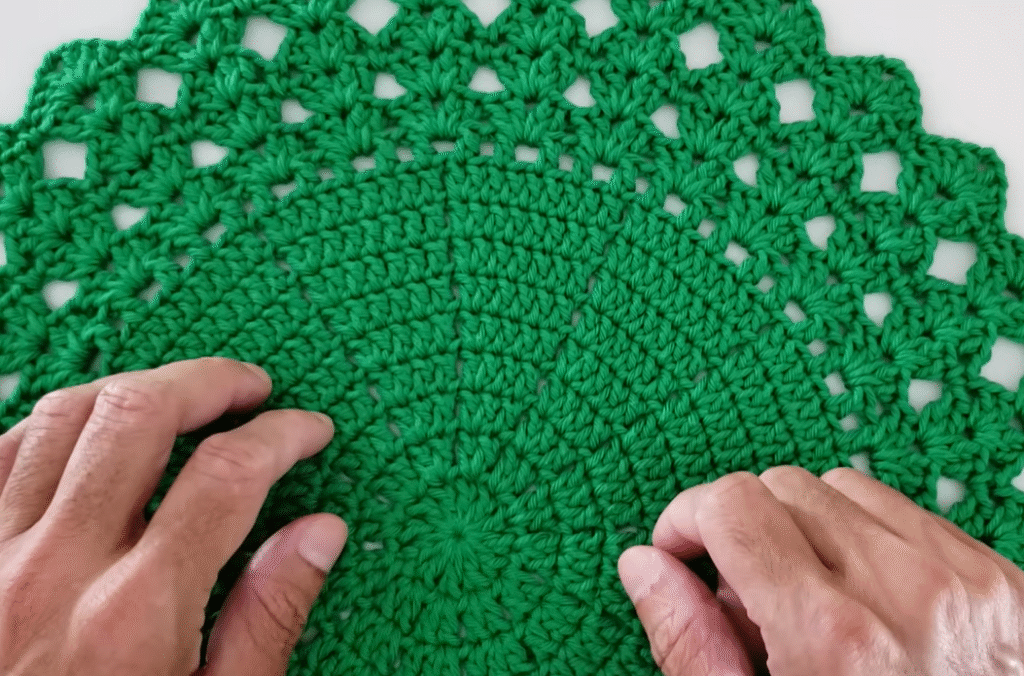
6. Missed or Wrong Join
Incorrectly joining rounds can result in unsightly gaps or uneven seams. This can be frustrating, especially if the mistake happens near the center of your doily.
How to Fix It:
- Learn the Right Join Method: If the pattern calls for a slip stitch join, ensure you’re doing it correctly. Some patterns require specific techniques, such as invisible joins or chainless joins, which help reduce the visibility of the seam.
- Seamless Join: If you want a more seamless look, use an invisible join method, which minimizes the appearance of the stitch where you connect your rounds.
7. Inconsistent Stitch Count in the Round
When crocheting in the round, it’s important to keep track of how many stitches you’ve made. An inconsistent stitch count can cause uneven shapes, especially in the last few rounds.
How to Fix It:
- Count the Stitches After Each Round: Always count your stitches after finishing each round to ensure you’re on track.
- Use a Marker for Rounds: Place a stitch marker at the beginning of each round to easily spot the start and end of the round. This will help you keep track of your stitch count.
8. Tangles or Knots in the Yarn
Tangles and knots can be a common nuisance, especially when working with multiple skeins of yarn.
How to Fix It:
- Untangle Gently: If you encounter a knot, stop and untangle the yarn slowly and carefully. Using your fingers to gently tease out the knots is often the best approach.
- Use Yarn with Fewer Kinks: Choose smoother yarns that are less prone to tangling. Yarn with a twist or texture, such as boucle or chenille, can be harder to work with and more likely to knot.
- Organize Your Yarn: If you’re using multiple colors, ensure each ball or skein is wound neatly to avoid unnecessary tangles. Keeping yarn in bags or baskets can also prevent chaos.
9. Joining Multiple Doilies
Sometimes, you may want to create a larger piece by joining multiple sousplat doilies together, such as for a tablecloth or a bedspread. Getting the joins right is essential for the final piece to look cohesive.
How to Fix It:
- Match Stitches: When joining multiple doilies, ensure that the stitch counts match at the points where you connect. If necessary, adjust the final round of the doily to match up with the adjoining pieces.
- Seamless Joins: To avoid bulky seams, use an invisible join method. This helps create a smooth, seamless finish that looks polished and neat.

Video Tutorial:
10. Conclusion: Perfecting Your Crochet Sousplat Doily
With these troubleshooting tips, you are now armed with the tools you need to address common issues that arise while making your crochet sousplat doily. Remember that crochet is as much about learning from your mistakes as it is about celebrating the small victories. Each time you make a fix or adjustment, you grow as a crocheter and become more confident in your skills.
As you continue to create beautiful, functional, and customizable crochet sousplats, don’t forget to experiment with new yarns, colors, and designs. Your creations can enhance your home decor, delight guests, or make thoughtful gifts that last a lifetime.
Now that you have a solid understanding of the entire process—from start to finish—embrace your creativity and let your crochet sousplat doily evolve into something uniquely yours.
Happy crocheting!
You may be interested:
- Master the Art of the Lace Flower Crochet Stitch
- Easy Knitted Slipper Socks You Can Make
- Easy Crochet Rectangle Shawl: A Beautiful, Versatile Piece for Your Wardrobe
- Crochet Lace Waves Motif

